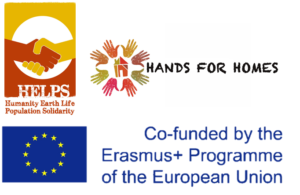Elements of definition
What do you mean by "Ecobuilding"?
In our sense we mean “building with local and natural materials (to the extent of possibilities), implementing traditional techniques, with respect to ancient (renovation of old buildings).
What do you mean by "People in precarious conditions"?
We mean “the populations living in a modest or very modest financial situation, following the criteria established by national authorities (in France the criteria of ANAH are based on fiscal revenues and the number of people living on this mentioned revenues).
Beneficiaries
How to find the beneficiaries?
A difficulty is to locate the beneficiaries. Enerterre has tested several methods. After experimentation, they feel like the best way is « to spread the word » (mouth to hear / viral message).
How to target the beneficiaries?
The heart of Enerterre target are people in social needs, who are geographically isolated (remote rural areas), and socialy isolated. A secondary target are the « autobuilders ». We have to bear in mind that the mixity of people and beneficiaries is a key for Enerterre. It eventually prevents from having the etiquette « works for poor people », that would be devalorising.
How to make people want to be a beneficiary?
The difficulty to engage beneficiaries in precarious conditions of habitat relies on the fact that it is hard to say « I need help », or « come to my place and I will tell you how bad it is ». One solution that Enerterre used was to make them come on other collaborative building sites, so that they feel useful and can imagine doing one at their house.
Objectives
Is energy a main objective?
Energy is a key driver and indicator, however the objective of energy performance is not compulsory and central in the framework of Enerterre. If a local stakeholder feels it is important, it can become central in its adaptation of Enerterre in his country. Note that Enerterre ambition would rather be « to avoid bad housing » than « to get a very performant house ». However most often, improvements of energy use and comfort are made. In every case, we need a global approach, an overall plan to improve the house and the living conditions inside it.
What about the inclusion of migrants?
The possibilities of inclusion of migrants aren’t so obvious in every country. This aspect is not central for the adaptations of Enerterre, we can consider it as optional. In particular, it seems that they could not be interested because they are only passing through the country. In France Enerterre involved migrants who were very happy to help, eventhough they didn’t want to stay. To avoid confusion and ensure a better local anchorage, local stakeholders can clarify that their main target is « people in social difficulties ».
Regulation
How do you solve building law?
In Italy for example, earth is not recognised as a building material. Enerterre, as ecobuilding in general, is dealing with a lot with legal issues. However contexts are different in every country. Actually, part of the solutions found in France leant on avoiding dead ends and sneaking around. Legal aspects definitely need to be part of the research.
Buildings
Is it possible to renovate a public building?
The Enerterre scheme is meant to be used at someone’s habitat (privately or publicly owned).
Can EU funds benefit to private individual houses?
We have several examples in Normandy of EU funds made available to retrofit individual private housing rather than public buildings (under conditions of collective interest).
Building site
How long does a typical Enerterre building site lasts?
The average is a session of 4 to 5 days, that can also be repeated at the same place. Then is depends on the number of volunteers (the more, the less time), the possibilities of spatial repartitions of the works (concomitant work of dozens of volunteers in the same house).
Method
How do you select your “working party organizer” ?
Enerterre looks for people technically and pedagogically capable. Someone with skills and who likes to transfer hem.
Public buildings
What about ASSR (Accompanied and Shared Self-Rehabilitation) in public buildings ?
The charter mentions that ASSR concerns housing (so yes, it can be public buildings, as long as they are a place of life). Thus, public buildings that are not houses can serve as preliminary and experimental construction sites to reassure and educate public institutions and residents who may participate in the future. This is a necessary first step for some organizations throughout the project, but we must keep in mind that not all the conditions of Accompanied and Shared Self-Rehabilitation are fully met in this situation.


